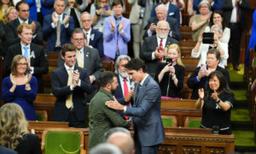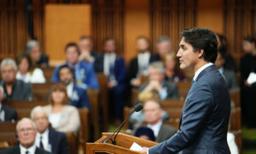Canadian members of Parliament gave a standing ovation in the House of Commons for a former member of the Waffen SS, a Nazi division accused of war crimes during WW2
Mr. Rota apologized following the incident on Sept. 24, saying the decision to recognize Mr. Hunka was "entirely my own" and extended his "deepest apologies to Jewish communities in Canada and around the world." Mr. Rota added that before recognizing the man in Parliament, he had not been aware of his connections to the Nazi regime.
MPs from all parties have subsequently said Mr. Hunka should not have been honoured in Parliament. Many in the Conservative Party are questioning how a former member of the Waffen SS member was able to slip past the vetting process and receive roaring applause from Canadian politicians.
4th Waffen Grenadier Division
From 1932 to 1933, Ukraine's population was decimated by a famine that was exacerbated by policies implemented by the Soviet Union. The Communist Party's decision to collectivize agriculture led to a drop in food production in Ukraine, leading to the deaths of up to 5 million Ukrainians in a famine known as the Holomodor.When Nazi Germany invaded the Soviet Union in 1941, they were greeted as liberators by some Ukrainians, who believed the fascist country would be a natural ally in Ukraine's quest for independence. While the Ukrainians' new occupiers continued to brutalize them, by 1943 the Organization of Ukrainian Nationalists had organized a multinational force to fight on behalf of the retreating Nazi army.
During that time, Mr. Hunka fought with the 4th Waffen Grenadier Division of the SS, the military wing of the Nazi Party. The unit consisted of troops from the Galicia region in western Ukraine and was armed and trained by the Nazis.
Ukrainian Nazis Arrive in Canada
According to the Canadian military magazine Esprit de Corps, an estimated 2,000 members of the Waffen SS came to Canada after the war. While Canada would not accept immigrants that had voluntarily served the Nazis, Flight Lt. Bohan Panchuck, who started the Ukrainian Canadian Servicemen’s Association, was able to bring the Ukrainians to the country by lying about their past.Flight Lt. Panchuck, who helped over 30,000 Ukrainian refugees come to Canada after the war's end, put forth a “positive narrative" that portrayed the unit as victims who had been forced to fight against the Soviets against their will, according to Espirt de Corps. The Royal Canadian Air Force officer made no mention of the group's connections with the SS.
While being held in a camp in Italy in the last days of the war, the 14th Waffen SS Division Galicia had also changed its name to the First Division Ukrainian National Army in order to hide its Nazi past.
Some members of the Canadian-Ukrainian community were also aware of the unit's past, and the Association of United Ukrainians in Canada put forth a campaign to stop the former Nazi collaborators from arriving in Canada.
“Ukrainian Division (Galicia) was part and parcel of the Hitler army. It was against them that our Canadian boys fought on the battlefields of Italy. Many a Canadian son remained over there, shot by the VERY ONES that Mr. Panchuk would wish your Department to bring to Canada," the association wrote to Canadian immigration officials, according to Esprit de Corps.
Ultimately, Lt. Panchuck's campaign was successful and 2,000 members of the 14th SS Division Galicia arrived and settled in Canada in the 1950s.Deschenes Commission
In 1985, then-prime minister Brian Mulroney called for a royal commission to determine whether Canada had become a safe haven for war criminals. The Deschênes Commission subsequently found there were about 600 former members of the Waffen-SS Galicia Division living in Canada at the time, but that the country did not have the legal means to prosecute them.As a result of the Deschenes Commission, the Canadian Criminal Code was amended in 1987 to allow suspected Nazi war criminals living in Canada to be tried. Prosecutors later pressed charges against at least four men on allegations of participation in Holocaust-related war crimes, but one case ended in acquittal, two cases were dropped when prosecutors had trouble obtaining overseas evidence, and the fourth case was stayed due to the defendant's health.
https://www.theepochtimes.com/world/in-depth-how-did-former-nazis-end-up-in-canada-5497918





No comments:
Post a Comment